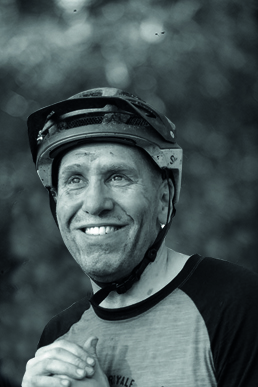Yeti’s unique Switch Infinity suspension set-up spans several bikes, with the SB130 being the most trail-focused version.
The latest frames have dialled fixtures and hardware, and good top tube standover clearance for easily shifting body weight.
Yeti SB130 T-Series X01 Eagle 01 frame
As you’d hope for the price, this SB130 uses the brand’s premium ‘TURQ’ build, with top-tier carbon fibre and a lay-up that saves 250g.
It’s gorgeous, with smooth lines and curves that scream ‘industrial beauty,’ as well as having properly modern geometry, translating to a 480mm reach on the large.
The funky-looking Switch Infinity design sees the main pivot move on two Kashima-clad sliders. This allows Yeti to fine-tune the suspension feel and virtual pivot location (the point the rear wheel cycles around throughout the travel). The goal is enough anti-squat for efficient pedalling around the sag point, and smoother absorption of bigger hits deeper in the stroke.
It sounds complicated, but works seamlessly. You do need to keep the greased bushings well lubricated and cared-for in UK conditions though (Yeti recommends every 40 hours).
The internal cable routing and frame protection is logical and quiet, and there’s room for a water bottle.
Yeti SB130 T-Series X01 Eagle 01 kit

While the own-brand bar, stem, dropper and contact points are fully dialled, there are some cut corners for a seven-grand bike.
DT Swiss’s M 1700 wheels are less snappy and reactive than the pricier EX 1501s on the Foxy, although you at least get a wide, grippy Maxxis Minion DHF front tyre.
While the Aggressor rear is decent for trail riding, it’s not great for scrubbing speed in wet dirt and is poor in mud. The frame will fit up to a 2.5in tyre though, so something beefier is an easy swap away.
Although the 12-speed SRAM ‘X01 Eagle’ drivetrain works well, Yeti saves cash with a heavier cassette and cheaper chain.
A bigger issue is the twin-piston Shimano XT brakes. As well as being specced with cheap rotors, the samples on my test bike had the same bite-point issues we’ve experienced on other sets.
Yeti SB130 T-Series X01 Eagle 01 ride impressions
The SB130’s rider position is near perfect. Seated and climbing, your hips are perfectly placed to put down the power.
Standing up, your hands and feet are ideally positioned to shred. It may only have 130mm of travel, but the Yeti pummels along beaten-up tracks with serious drive, and maintains good speed over the rough stuff and repeated impacts too.
That said, the Fox DPX2 shock doesn’t offer the most sensitive rear suspension in the world. The frame transmits significant bumps, and the shock dives through its mid stroke too eagerly if you really load the back tyre.
You can easily use full travel on big-hit landings as well, and if you try to counter this by adding more air, the ride becomes too harsh off the top.

These are all subtle (rather than drastic) points, because the bike is well-balanced and easy to ride, but they’re fair comment on kit this expensive.
There’s no arguing that the Yeti goes like hell downhill on medium-gradient terrain. The fork offset, steering and head angle combination is good, but the frame isn’t particularly stiff or precise in terms of front-end steering response.
Combined with the lack of mid-stroke support (so the rear end wants to squat too much), this makes for moments both in flatter turns and deep berms (with the recommended air pressure and sag) where turning feels awkward and rider weight is slightly unstable in the apex.
This makes it harder to pop in and out of linked turns because the bike needs more muscle to really lean it over and slash corners, which feels less natural than some other bikes also on test.
The SB130 pedals and climbs fairly (but not exceptionally) well. It’s fast, solid and super-fun, but the temperamental brakes were annoying. Ultimately, I can’t see a reason to choose this over the SB150, which is equally efficient and way more capable downhill.
Yeti SB130 T-Series X01 Eagle geometry
- Seat angle: 69.6 degrees
- Head angle: 65 degrees
- Chainstay: 17.24in / 43.8cm
- Seat tube: 18.98in / 48.2cm
- Top tube: 24.92in / 63.3cm
- Bottom bracket height: 13.62in / 34.6cm
- Wheelbase: 48.5in / 1,232mm
Product
| Brand | yeti |
| Price | 6999.00 GBP,7299.00 USD |
| Weight | 13.4000, KILOGRAM (L) - without pedals |
Features
| Fork | Fox Float 36 Factory FIT4, 150mm (5.9in) travel |
| br_stem | Race Face Æffect 35, 40mm |
| br_chain | SRAM GX Eagle |
| br_frame | TURQ carbon fibre, 130mm (5.1in) travel |
| Tyres | Maxxis Minion DHF EXO TR 3C MaxxTerra 29x2.5in Wide Trail (f), Maxxis Aggressor EXO 29x2.3in (r) |
| br_brakes | SRAM Guide RSC, 200/180mm rotors |
| br_cranks | SRAM X01 Eagle carbon |
| br_saddle | Syncros Tofino 1.5 |
| br_wheels | DT Swiss M 1700 Spline 30, alloy |
| br_headset | Syncros FL 1.5 |
| br_shifter | SRAM X01 Eagle |
| br_cassette | SRAM GX Eagle, 10-50t |
| br_seatpost | Fox Transfer, 150mm |
| br_gripsTape | Ergon GE1 |
| br_handlebar | Yeti carbon, 780mm |
| br_rearShock | Fox DPX2 Factory EVOL |
| br_bottomBracket | SRAM DUB BB92 |
| br_availableSizes | S, M, L, XL |
| br_rearDerailleur | SRAM X01 Eagle (1x12) |
